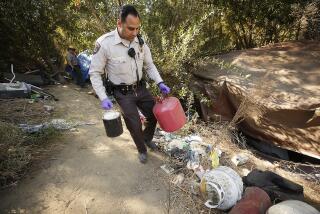S.D.’s Thin Blue Line : The city needs more police officers, but public must be willing to pay for them
- Share via
In the best of years, San Diego’s police force is small for a 400-square-mile city of 1.1 million people. The numbers come out to just 1.6 officers per 1,000 population. But, with a record number of homicides, this is among the worst of years, and the 1,850-officer force is stretched thin.
Just how thin was recently illustrated in a story by Times staff writer Mark Platte, who took a look at the numbers behind the numbers: What does 1.6 officers per 1,000 mean on a given shift? After subtracting out investigating detectives and supervisors, then dividing the day into shifts and taking into account normal sick leave, vacation and vacancies, there may be fewer than 100 officers on the street at one time.
That’s a dangerously thin blue line.
Twenty-five percent to 30% of the time the number of patrol officers fall below the minimum staffing the department recommends for public safety. Response times for life-and-death emergencies average six to eight minutes. More routine calls--burglaries, car thefts, minor assaults, et cetera, which to most victims are hardly routine--may have to wait five or six hours.
For years, police officials and the City Council have talked about increasing the police force by nearly 25% to two officers per thousand.
But budget constraints--brought on in part by the Proposition 13 property tax limits approved by voters in 1978--have made it difficult to just keep the 1.6 ratio as the city grows.
The two-officers-per-thousand goal is not a magic figure that will automatically reduce crime. But the current force is inadequate. Adding nearly 400 officers would not only mean officers could respond more quickly, it would also allow a greater use of “neighborhood policing,” a more prevention-oriented approach.
But the additional officers could cost about $38 million a year, including support personnel, but not counting the extra prosecutors, police facilities, jail and court space needed to back up a larger police force.
The San Diego Police Officers Assn. is considering taking the issue directly to the voters. The union is considering a ballot measure that would force the City Council to meet or exceed the two-officer goal over five years without a tax increase.
It’s refreshing to see a union interested in more than wages and grievances. The POA could be a very effective advocate. But it should carefully consider its timing and approach.
If additional jail space remains the No. 1 priority of local law enforcement officials, the POA would be wise to wait until the Supreme Court rules on the legality of the 1988 sales-tax increase for jails and courts. If the court overturns the tax measure, then the POA’s efforts might be needed to get a new tax measure approved by two-thirds of the voters.
The more fundamental question, however, is what it would mean to other city services if the council had to fund a nearly 25% increase in police from existing resources.
As much as San Diego needs to increase its police force, such a major expansion should not be done at the expense of libraries, parks, recreation centers, road maintenance, building inspections, the city attorney. Some of these play a key role in crime prevention, too.
The state and the county have found out all too painfully the effects of mandated levels of services.
Proposition 98, passed by the voters in 1988, required that 40% of the state budget be set aside for schools and community colleges. But, as the state found out during budget wrangling this year, this rigid formula is difficult to honor in tough economic times.
The county has also felt the crunch of mandated services. Services required by the state and federal governments, without adequate funding, have put a noose around the county budget, resulting in drastic cuts in health services.
San Diego needs more police officers. But San Diegans must be willing to pay for them. That means a tax increase.
The POA could do the community a great service by helping voters accept this reality. Otherwise, good intentions could produce costly consequences.
More to Read
Sign up for Essential California
The most important California stories and recommendations in your inbox every morning.
You may occasionally receive promotional content from the Los Angeles Times.










